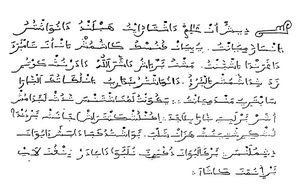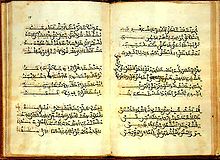Muladí
Muladí (
Etymology

The Spanish, Portuguese and Catalan words muladí, muladi or muladita are derived from the Arabic muwallad. The basic meaning of muwallad is 'a person of mixed ancestry', especially a descendant of one Arab and one non-Arab parent,
Muwallad is derived from walad (ولد), which means 'descendant, offspring, scion, son'. Muwallad referred to the offspring of Muslim men and foreign, non-Muslim women. The term muwalladin is sometimes used in Arabic to this day to describe the children of Muslim fathers and foreign mothers.[6][7][8]
According to Dozy, Muwallad means "anyone who, without being of Muslim origin, is born among the Muslims and has been raised as an Arab".[9] The word, according to him, does not necessarily imply Arab ancestry, either paternal or maternal.
According to the dictionary of the
History
This article may be unbalanced towards certain viewpoints. (June 2023) |
This article relies largely or entirely on a single source. (June 2023) |
In
Some christians who converted to Islam became
The Muwallads were also called Muslima ('Islamized'), and elches (ilj, plural: ulus), in reference to the society from which they sprang. They later were denominated
Through the cultural

The Muwallads primarily spoke
In the process of acculturation, Muwallads may well have adopted an
Among the Muwalladun were the free-born, the enfranchised, and
The intermarriage of foreign Muslims with native Christians made many Muwallads heedless of their Iberian origin. As a result, their descendants and many descendants of Christian converts forgot the descent of their ancestors and assumed forged Arab genealogies.[16] However, there were a few who were proud of their Roman and Visigothic origins. These included the Banu Angelino and Banu Sabarico of Seville, Banu Qasi of Aragon, Banu l' Longo and Banu Qabturno. Several Muwallad nobles also used the name Al-Quti, ('the Goth'),[17] and some may have been actual descendants from the family of the Visigothic King of Hispania, Wittiza.[16]
The conversion of the native Christians to Islam did not mean the total erasure of previous beliefs and social practises. There is some evidence of a limited cultural borrowing from the Christians by the Muwalladun and other Muslims in Al-Andalus. For instance, the Muslims' adoption of the Christian

Many Muwallads held key posts in the departments of civil administration, justice, and the armed forces.
In about 889 a ship carrying twentySeveral Muwalladun became rich and powerful magnates by means of trade, agriculture, and political activity. The Muwallads of the town the Christians called Elvira (nowadays Granada), after the former Iberian name Ilbira, had become so powerful during the reign of
The Muwalladun were the mainstay of the economic framework of the country. Together with the Mozarabs they constituted the productive classes which were craftsmen and small tradesmen in the towns, and farmers and labourers in the rural countryside. However, they were inferior to the Arabs and Berbers in social status. Prominent positions in government and society were usually not available to individuals of Muladi descent. In spite of the Islamic doctrine of equality and brotherhood of Muslims, the Muwalladun were often looked down upon with the utmost contempt by the Arab and Berber aristocrats and were usually pejoratively referred to as "the sons of slaves".[16]
The Muwallads, in turn, in spite of their profession of faith, despised the Arabs whom they viewed as colonialists and foreign intruders. This mutual feeling of hatred and suspicion provoked frequent revolts and led the Muwallads to support the
In Al-Andalus, the large numbers of Christians adopting Islam prompted concern among the authorities about the weakening of the tax base and further inflamed resentment towards the Muwallads.[21]
The Muwallads were in almost constant revolt against the Arab and Berber immigrants who had carved out large estates for themselves, farmed by Christian serfs or slaves.
There were also other Muwallad revolts throughout Al-Andalus. In the Elvira region, for instance, discord sprang up between the Muwallads and Moors, the latter being led by Sawar ibn Hamdub, and the poet, Sa'ad ibn Judi, both of whom fluctuated between insurrection against Abd'Allah and submission to him. In Seville, the second largest city after Córdoba, there was a vicious feud between the two Arab aristocratic families, Banu Hajjaj and Banu Khaldun, and two Muwallad noble families, Banu Angelino and Banu Sabarico, which finally left Ibrahim ibn Hajjaj as the ruler of an independent city-state.[16]
In 805, the Muwallads of Córdoba, incited by certain theologians, revolted against the Umayyads under Hakim I, but the uprising was suppressed. In 814, there was a second revolt of Muwallads in Corboba, and this time the revolt was put down with the utmost severity, and resulted in the expulsion of 9,500 Muwallads from Córdoba, with over 1,500 going to
The Muwallads were sometimes assisted by the local Mozarab population, and occasionally by the Christian powers in their revolts. For instance, when the Muwalladun of Toledo revolted, aided by the large Mozarabic population of the city, Ordoño I of Asturias, promptly responded to their appeal for help, but the Emir's forces were routed by the Toledans and Asturians on the Guadacelete in 854.[16]
Many minor rebels from among the Muladi leadership took possession of various sites, their descendants eventually becoming semi-independent Emirs. These included:
- Ubayd Allah ibn Umayya ibn Shaliya in Shumantan (present-day Somontin in the region of Jaén),
- Saʿid ibn Mastanna in Baghu (Priego),
- Khayr ibn Shakir in Shudhar (Jodar),
- Saʿid ibn Hudhayl in al-Muntliyun (Monleonnear Jaén),
- Daysam ibn Ishaq in Murcia and Lurqa (Lorca),
- ʿAbd al-Malik ibn ʿAbd-al Jamal in Beja and Mirtula (Mértola) in Portugal,
- Bakr ibn Yahya in Shantamariyyat
- Muhammad ibn ʿUmar ibn Khattab ibn Angelino, of Abd ar-Rahman III
On the western frontier of Al-Andalus, the Muwalladun and Berber families divided control of the region containing Mérida, Badajoz, and their environs.[16]
Notable Muladi
- Abu Hafs
- Abu Jafar ibn Harun al-Turjali
- Abu Taur of Huesca
- Al-Tutili
- Al-Udri
- Ibn-Rushd (Averroes)
- Al-Qurtubi
- Amrus ibn Yusuf
- Ibn al-Qūṭiyya
- Ibn al-Yayyab
- Ibn at-Tafiz
- Ibn Ammar
- Ibn Faradi
- Ibn Gharsiya
- Ibn Hazm
- Ibn Marwan
- Ibn Quzman
- Muhammad al-Tawil of Huesca
- Musa ibn Musa al-Qasawi
See also
- Moors
- Umar ibn Hafsun
- Mozarabs, local population who remained Christians as dhimmis.
- Banu Qasi, a Muladi family descending from a Visigothic lord Cassius who became the independent rulers of their own taifa.
- Mudéjars, Muslims living under Christian rulers.
- Moriscos, former Muslims who converted to Catholicism.
- Wulayti
Footnotes
- ^ Miteva, Yuliya Radoslavova (2018). "Identidades fronterizas en el contexto andalusí: los muladíes" [Border identities in the context of Al-Andalus: the Muwallads]. Cuadernos Medievales (24). Mar del Plata: Universidad Nacional de Mar del Plata: 15–17.
- ISBN 978-1-4039-8131-8.
- ISBN 978-0-252063213.
- ^ Dozy, the history of Islamic Spain, Arabic translation, vol 1, p: 156.
- ISBN 978-90-04-14480-4.
- ^ Kees Versteegh, et al. Encyclopedia of Arabic Language and Linguistics, BRILL, 2006.
- ISBN 978-0-7914-8935-2. Retrieved 26 May 2013.
- ISBN 978-0-549-89033-1. Retrieved 26 May 2013.
- ^ cited by Monique Bernards and John Nawas. Patronate and patronage in early and classical Islam. BRILL, 2005. Page 220.
- ^ "Diccionario de la lengua española | Edición del Tricentenario".
- ^ Bernards and Nawas 2005, p. 220
- ^ "mulatto". The American Heritage Dictionary of the English Language (5th ed.). HarperCollins. Retrieved 26 Sept 2017
- ^ "mulatto". Merriam-Webster.com Dictionary. Retrieved 2017-09-26.
- .
- ^ Kenneth Baxter Wolf (1988), "Christians in Muslim Córdoba", in Christian Martyrs in Muslim Spain, Cambridge University Press.
- ^ a b c d e f g h i j k l m n o S. M. Imamuddin, Some aspects of the socio-economic and cultural history of Muslim Spain 711–1492 A.D., pp. 26–29
- ISBN 978-90-04-11206-3.
- .
- ^ Description of annular gourd at Qantara website Archived 2011-10-08 at the Wayback Machine
- ^ Enderwitz, S. "Shu'ubiyya". Encyclopedia of Islam. Vol. IX (1997), pp. 513.
- ^ .
- ^ (in Spanish) El caudillo muladí Umar bin Hafsún, pesadilla de los emires de Córdoba
References
- Thomas F. Glick: Islamic and Christian Spain in the Early Middle Ages
- S. M. Imamuddin, Muslim Spain 711–1492 A.D.: A Sociological Study, ISBN 90-04-06131-2.
- Harvey, L. P. Muslims in Spain, 1500 to 1614: 1500 to 1614 . ISBN 0-226-31963-6
- Salma Khadra Jayyusi, Manuela Marín. The Legacy of Muslim Spain. ISBN 90-04-09599-3
